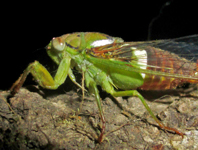Abstract
The present study describes Serranochromis alvum n. sp., Serranochromis swartzi n. sp., Serranochromis cuanza n. sp., and Serranochromis cacuchi n. sp. from Angolan tributaries of the Cuanza and Okavango systems in Angola. The presence of four or five scale rows between the posterior margin of the orbit and the ascending arm of the preoperculum, the presence of widely set unicuspid teeth on the jaws, widely separated gill rakers, and anal fins with egg ocelli place these four species in Serranochromis. The Serranochromis described herein are distinguishable based on a combination of morphological and meristic characters, as well as pigmentation patterns. The interorbital width (14.3–15.9 % HL) of S. alvum is narrower than that of S. swartzi (17.6–19.8), S. cuanza (16.3–18.0), and S. cacuchi (20.0–21.7). Moreover, the interorbital width of S. cacuchi is greater than the other three described species. Serranochromis swartzi has a smaller preorbital depth (16.2–18.9 % HL) and snout length (29.6–31.9 % HL) than Serranochromis cuanza (PD 19.1–22.2, SNL 35.2–39.6 % HL). Serranochromis alvum is known only from the type locality at Cuito-Cuanavale at the junction of the Cuito and Cuanavale rivers, tributary to the Okavango River in Angola. Serranochromis swartzi is known only from the type locality in the Cuanza River, Angola. Serranochromis cuanza is restricted to the Cuanza River, below Capanda Dam, Angola, while S. cacuchi is known only from the Cacuchi River, a tributary of the Cuchi-Cubango River in Angola. The limited distribution of all four species and the absence of many congeners suggest, that in addition to previous studies that invoked a lacustrine speciation model, vicariance through drainage isolation seems to have played an important role in driving speciation in this group. The minimum polygon clusters that are formed when the first principal components of the meristic data are plotted against the second sheared principal components of the morphometric data show separation of the four new species.
References
Bookstein, F., Chernoff, B., Elder, R., Humphries, J., Smith, G. & Strauss, R. (1985) Morphometrics in evolutionary biology. Special Publication 15. The Academy of Natural Sciences of Philadelphia. Philadelphia, Pennsylvania, 277 pp.
Burrough, S.L., Thomas, D.S.G. & Bailey, R.M. (2009) Mega-Lake in the Kalahari: a late Pleistocene record of the Palaeolake Magadikgadi system. Quaternary Science Reviews, 28, 1392–1411.
https://doi.org/10.1016/j.quascirev.2009.02.007
Greenwood, P.H. (1979) Towards a phyletic classification of the `genus’ Haplochromis (Pisces, Cichlidae) and related taxa. Part 1. Bulletin of the British Museum (Natural History), Zoology, 35 (4), 265–322.
https://doi.org/10.5962/bhl.part.20455
Greenwood, P.H. (1993) A review of the serranochromine cichlid fish genera Pharyngochromis, Sargochromis, Serranochromis and Chetia (Teleostei: Labroidei). Bulletin of the Natural History Museum London, Zoology, 59 (1), 33–44.
Humphries, J.M., Bookstein, F.L., Chernoff, B., Smith, G.R, Elder, R.L. & Poss. S.G. (1981) Multivariate discrimination by shape in relation to size. Systematic Zoology, 30, 291–308.
https://doi.org/10.2307/2413251
Joyce, D.A., Lunt, D.H., Bills, R., Turner, G.F., Katongo, C., Duftner, N., Sturmbauer, C. & Seehausen, O. (2005) An extant cichlid radiation in an extinct Pleistocene lake. Nature, 435, 90–95.
https://doi.org/10.1038/nature03489
Jubb, R.A. (1967) A new Serranochromis (Pisces, Cichlidae) from the Incomati River system, Eastern Transvaal, South Africa. Annals of the Cape Provencial Museum, 6, 55–62.
Koblmüller, U., Schliewen, K., Duftner, N., Sefc, K.M., Katongo, C. & Sturmbauer, C. (2008) Age and spread of the haplochromine cichlid fishes in Africa. Molecular Phylogenetics and Evolution, 49, 153–169.
https://doi.org/10.1016/j.ympev.2008.05.045
Konings, A.F. & Stauffer, Jr., J.R. (2006) Revised diagnosis of Metriaclima with description of a new species (Teleostei: Cichlidae) from Lake Malaŵi National Park, Africa. Ichthyological Explorations of Freshwaters, 7, 33–36.
Moore, A.E. & Larkin, P. (2001) Drainage evolution in south-central Africa since the breakup of Gondwana. South African Journal of Geology, 104, 47–68.
https://doi.org/10.2113/104.1.47
Musilová, Z., Kalous, L., Petrtyl, M. & Chaloupkova, P. (2013) Cichlid fishes in the Angolan headwaters region: molecular evidence of the ichthyofaunal contact between the Cuanza and Okavango-Zambezi systems. PLoS One, 2013, 8, e65047
https://doi.org/10.1371/journal.pone.0065047
Regan, C.T. (1920) The classification of the fishes of the family Cichlidae. I. The Tanganyika genera. Annuals of the Magazine of Natural History, 5, 33–53.
https://doi.org/10.1080/00222932008632340
Schwarzer, J., Swartz, E.R., Vreven, E., Snoeks, J., Cotterill, F.P.D., Misof, B. & Schliewen, U.K. (2012) Repeated trans-watershed hybridization among haplochromine cichlids (Cichlidae) was triggered by Neogene landscape evolution. Proceedings of the Royal Society B Biological Sciences, 279, 4389–4398.
https://doi.org/10.1098/rspb.2012.1667
Skelton, P.H. (2001) A Complete Guide to the Freshwater Fishes of Southern Africa. Struik Publishers, Capetown, 395 pp.
Stauffer, Jr., J.R. (1994) A new species of Iodotropheus (Teleostei: Cichlidae) from Lake Malaŵi, Africa. Ichthyological Explorations of Freshwaters, 5, 331–334.
Stauffer, Jr., J.R., Bills, R., Skelton, P.H. & Weyl, O. (2020) Re-elevation to species level and redescription of Serranochromis jallae and Serranochromis robustus (Teleostei: Cichlidae). Zootaxa, 4858 (1), 126–134.
https://doi.org/10.11646/zootaxa.4858.1.9
Stauffer, Jr., J.R. & Hert, E. (1992) Pseudotropheus callainos, a new species of mbuna (Cichlidae) with analyses associated with two intralacustrine transplantations in Lake Malaŵi, Africa. Ichthyological Exploration of Freshwaters, 3, 253–264.
Trewavas, E. (1964) A revision of the genus Serranochromis Regan (Pisces, Cichlidae). Musee Royal de l’Afrique Centrale. Tervuren. Annales, Serie in -8º, Sciences Zoologique, 125, 1–58.
Winemiller, K.O. & Kelso-Winemiller, L.C. (1991) Serranochromis altus, a new species of piscivorous cichlid (Teleostei: Perciformes) from the upper Zambezi River. Copeia, 1991, 675–686.
https://doi.org/10.2307/1446393


